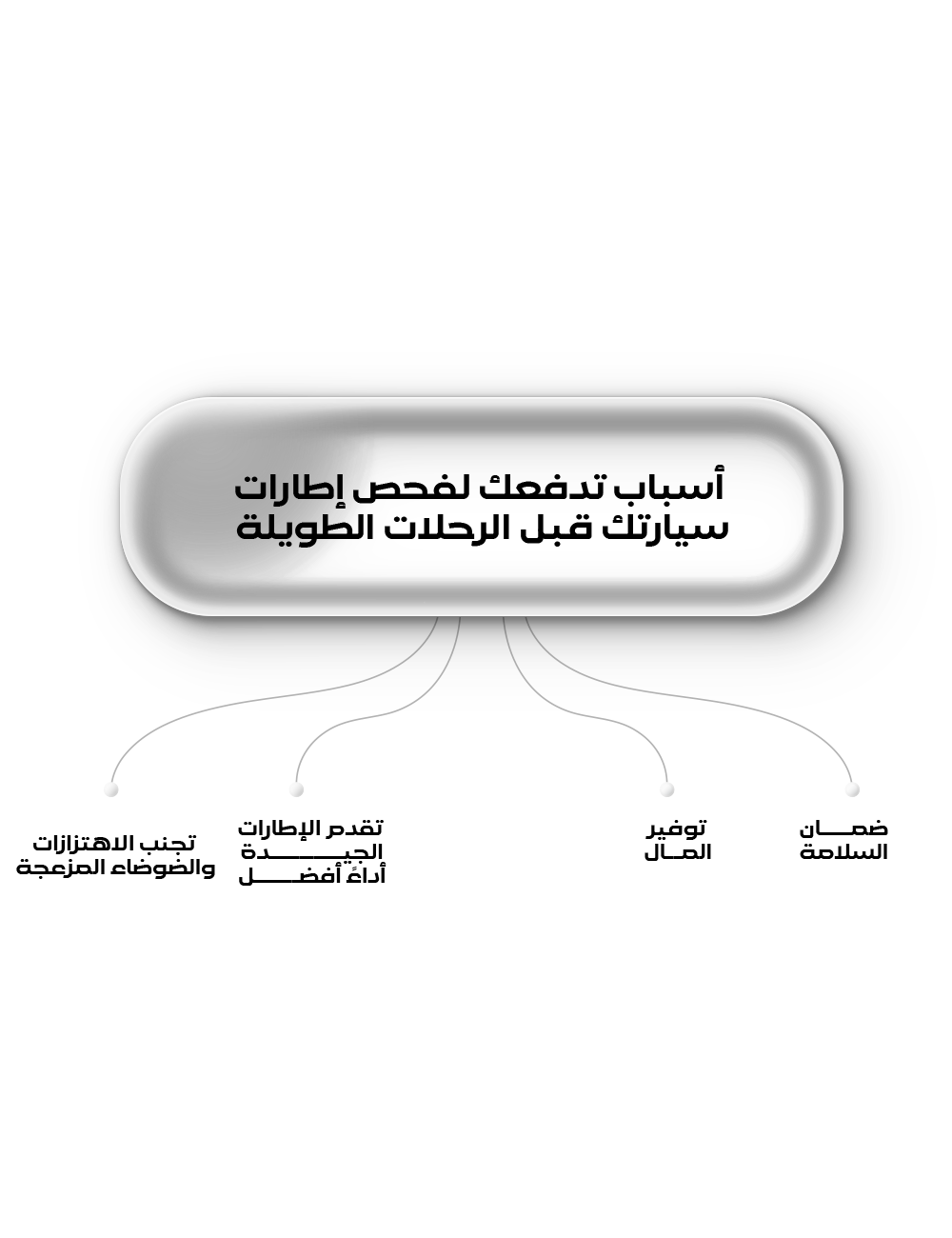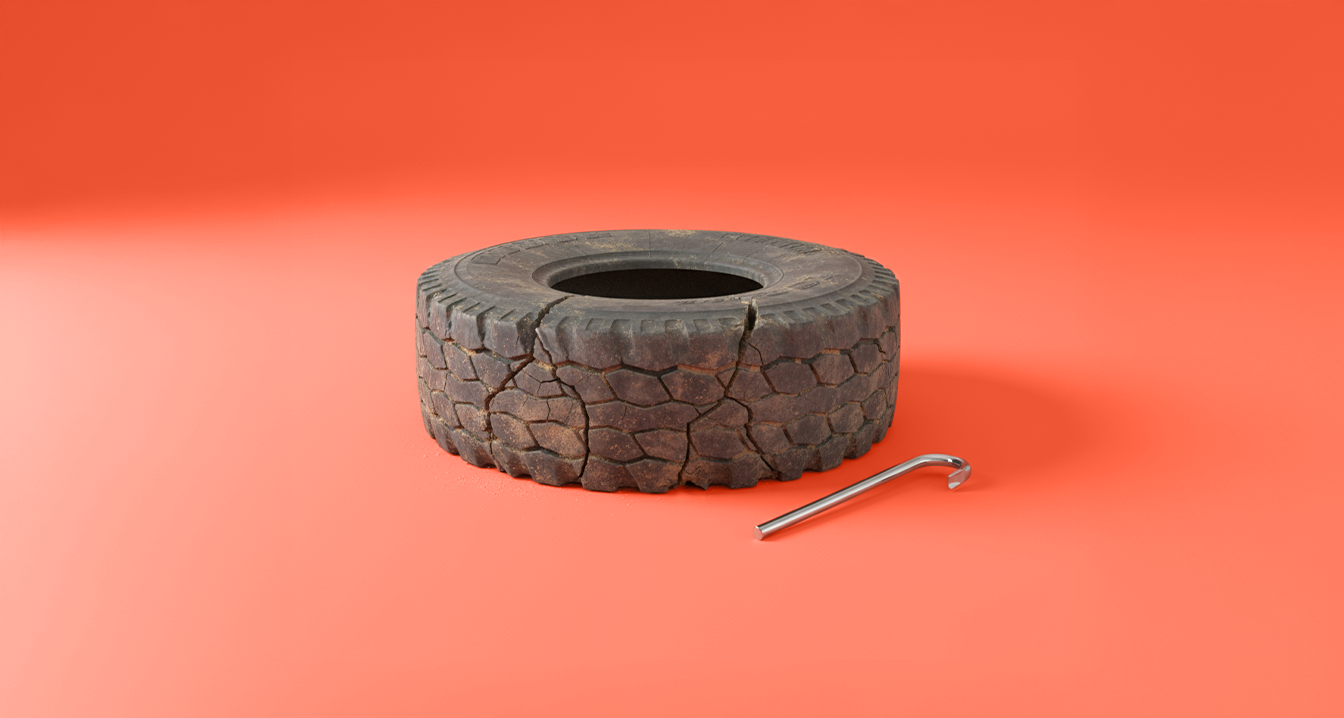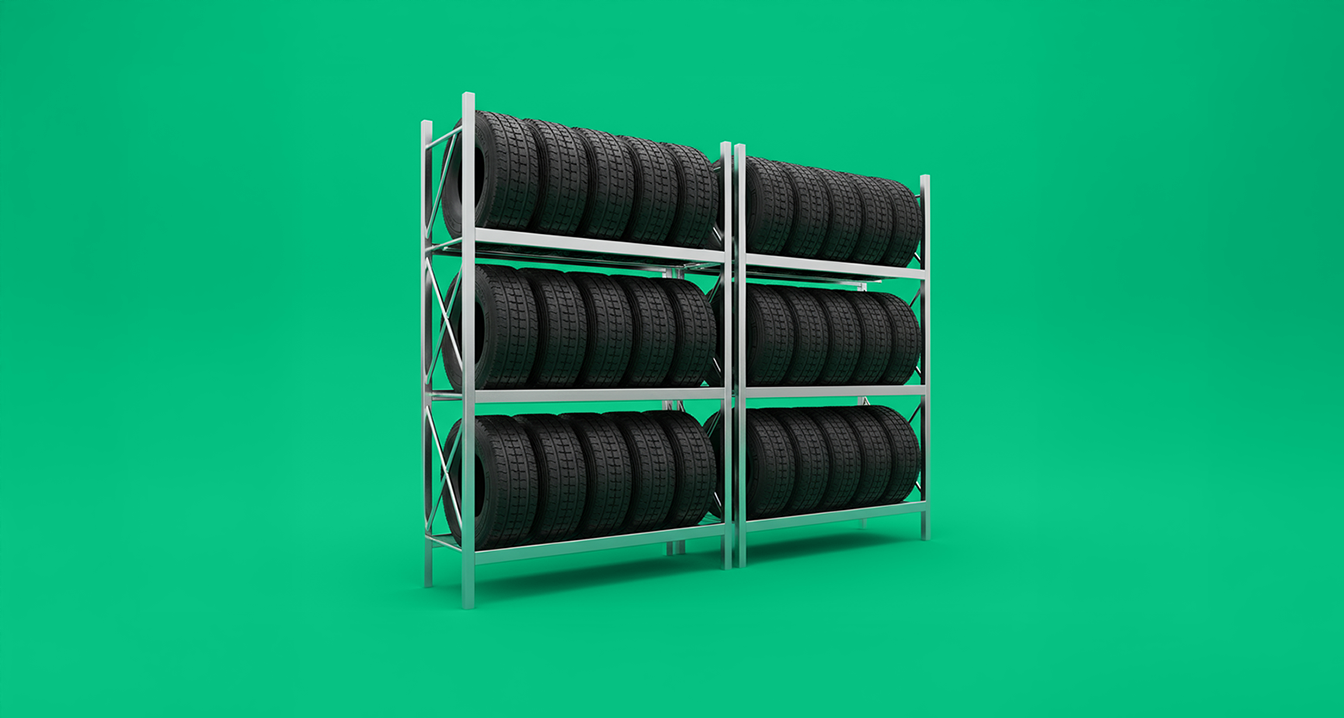We always recommend that you should check your tires before traveling and long trips, because it is the step that may save your life. Neglecting it may turn your trip into a nightmare, God forbid.
So before you put your foot on the gas pedal, make sure your tires are good and have no defects that will cause disaster and ruin all your trip plans.
In this article, we'll guide you to a quick checklist for checking tires before any travel, to ensure a safe and smooth ride.
This test will not take you more than a few minutes, but it may be the difference between arriving safely or facing unwelcome risks.
Follow us to learn about the mistakes that most drivers make, and how to avoid them easily. Do not leave your safety to chance.. Start checking your tires now.
A few minutes to check cracks, air pressure and depth of the tread may save you from road disasters.
5 reasons why you should check your tires before long trips
Road safety starts from the four points of contact between your car and the ground - tires - and requires special attention before any long journey. Let's review together the reasons why tire inspection is an indispensable procedure:

- Ensure safety by ensuring that there are no defects that may increase the risk of tire explosion.
- Save money, improve fuel efficiency and increase tire life.
- progression Good tires Better performance, stronger stability in turns and wet roads.
- Avoid annoying vibrations and noise and prevent sudden crashes on the road.
- Protecting the environment by reducing carbon emissions, and extending the life of tires contributes to reducing waste.
The risks of damaged tires
When you drive at 120 km/h on a highway and the car tire suddenly loses its balance due to negligence and leaving it worn, it undoubtedly turns into a time bomb.
Damaged tires not only burst, but may suddenly slip, especially in turns or when it rains.
Even minor wear on the tread increases Braking distance At a dangerous rate, it makes making simple turns a fatal challenge.
Even worse, many people discover the defect late, when they find themselves in the emergency room, God forbid, or facing an expensive repair bill.
Improper pressure, old tires and aggressive driving are hidden enemies of your car tires.
A quick checklist to check tires before traveling
You can follow this quick list of periodic checks before traveling to ensure the safety and optimal performance of your car tires:
- visual inspection
Look for any cracks, bulges, cuts, or exposed wires on the sides of the tire, and check for stuck foreign objects such as nails or stones.
- Tread depth
Use the currency test by placing it in the tire grooves. If a quarter appears, it means that the depth of the tread is worn and the tire must be replaced. Make sure that the depth is at least 1.6 mm “according to legal specifications in most countries.”
- air pressure
Use an air pressure gauge to check the pressure when the tires are cold - after the car has stopped for 3 hours - and compare the reading to the recommended pressure found on the driver's door or in the owner's manual, then adjust the pressure if necessary and don't forget the spare tire.
- The life of the tire
Check symbol “DOT” on the side of the tire to identify the manufacturing date “week and year”. Replace tires if they are over 6 years old, even if they are intact.
- Distribution and balance
Note that any uneven wear on the tire indicates the need to rotate or adjust the balance. Also, check for steering wheel vibration or car deflection while driving, as this may indicate a balance or steering problem.
Also, avoid overloading the permissible limit, as this increases tire pressure, and make sure that there are no distortions or rust in the wheels, with the need to provide emergency tools such as wheel switch, warning triangle, etc.
Common mistakes that damage your tires without you feeling
Did you know that there are some daily habits that accelerate the damage of your car tires without realizing it?! Here are the most common habits:
Driving with air pressure is not appropriate. Low air pressure leads to increased tire friction with the road, hence the heat of the rubber, the cracking of the sidewalls, and an increased risk of tire explosion.
Excessive air pressure makes the tire tough and more likely to explode when hit by bumps or potholes, and reduces the car's grip on the road.
Neglecting the rotation of tires and their stability in the same places without replacement for long periods. This leads to uneven wear, especially in the front tires that bear the weight of the engine and the power of steering and braking.
Loading the car with excessive weights, this increases tire pressure abnormally, so the internal structure is deformed and the tread is quickly damaged.
Extreme driving, such as sudden braking, rapid launch, and sharp turns that cause rapid and irregular tire wear. Hurting bumps and potholes quickly may lead to side bulges or cuts in the tire structure.
Using tires that are not suitable for the weather, such as using summer tires in winter or vice versa, reduces grip efficiency with the road and increases the risk of skidding.
Relying on old tires even with a good tread, because rubber loses its elasticity over time and becomes prone to cracking.
Neglecting to check the wheels. Crooked or rusted wheels cause tires to vibrate and accelerate wear. Failure to adjust the balance of the wheels after installing new tires leads to uneven wear.
Using tires that are over 6 years old, even if their tread depth is intact. These tires become brittle and explosive due to rubber oxidation.
We conclude from the above that there are warning signs in your tires that you should pay close attention to, because ignoring them may expose you to a real danger on the road, including: side cracks that appear on the tire walls, bulges that look like small swellings on the sides of the tire, irregular wear, whether in the center or edges of the tire, exposed metal wires or strange bumps indicate serious damage to the tire structure.
These signs are not just superficial defects. They are cries for help from your tires warning you of the need for immediate inspection or substitution Before it's too late.
Bad habits such as driving with inappropriate air pressure, loading excessive weight, or neglecting tire rotation contribute to their gradual destruction. Therefore, you should check them regularly and avoid these practices to ensure safety on the road.
Myths about tires you should stop believing
- There is no need to check tire pressure with a “TPMS” system. In fact, this system is not sufficient without periodic pressure checks to maintain your tires and ensure your safety.
- A spare tire is available in all vehicles. In fact, many modern vehicles lack this feature due to saving space, reducing their weight and relying on the quality of their tires.
- It is sufficient to rotate tires once a year. In fact, specialists recommend that you should rotate it every 4800 to 9600 kilometers.
- New tires should be installed on the front axle first. In fact, it is recommended to install new tires on the rear axle to improve vehicle stability, especially while driving on wet surfaces.
- There is no need to worry about wheel alignment except when obvious problems arise. In fact, it is recommended to check wheel alignment every 20,000 km or annually, whichever comes first, to maintain an even distribution of tire wear, fuel efficiency, better stability while driving, and reduce loads on the suspension system.
- There is no need to change the rear tires, because the front tires are the most important as they bear the weight of the engine and the steering. In fact, it is recommended to change all four tires together to maintain balance and optimal performance.
- Inflating the tires to the maximum limit on the sidewall is the best. In fact, the correct pressure is recommended by the car manufacturer, not the maximum stated on the tire, to ensure safety and efficient performance.
- Tire valve covers prevent aging and air loss. In fact, the function of covers is to protect the valve from dust and moisture only and do not prevent air leakage. Therefore, tire pressure should be checked regularly to maintain performance and safety.
- Reducing tire pressure improves vehicle control. In fact, very low tire pressure may increase the area of contact with the road, but it reduces performance and accelerates tire wear. Optimal control also depends on several factors, including appropriate air pressure, tread design, tire width, and road quality.
How do you use emergency spare tires while traveling?
A spare tire is a temporary solution to help you get to the nearest service center in the event of a sudden failure. The question here is: do you know how to use it properly?
Check the quality of the spare tire. Many modern cars have a spare tire designed for temporary use only with a maximum speed of 80 km/h and for short distances.
Note that exceeding the speed limit for the temporary tire may put you at risk of explosion or loss of control.
However, in some other cars you may find a regular spare tire with the full specifications of the original tire, allowing it to be used normally without restrictions.
Don't forget to check your air pressure regularly every 3 months, even if you haven't used it for a long time, to ensure it's ready when needed.
Also, keep in mind that a spare tire is a temporary solution only and does not replace immediate maintenance. Therefore, we recommend that you check the damaged tire and repair or replace it as soon as possible to ensure your safety on the road.
A spare tire is a temporary solution of a maximum of 80 km/h. It should be checked periodically even if it is not used.
The most important questions you should ask your mechanic about your car tires
Do not just hand the key to the mechanic when checking your tires, but ask him a set of important questions that help you ensure the quality of the tires and ensure safety on the road:
- What is the condition of the tire tread and do you need to replace it soon?
- Is the air pressure adjusted according to the required specifications found in the car manual or the driver's door.
- Are there any hidden damages, whether bulges, cracks, or foreign objects installed?
- Are the tires properly balanced?
- What is the actual age of these tires?
- Are these tires suitable for driving conditions in my area?
- What is the best brand for my car and budget? You can make comparisons between the right tires”From here“.
In conclusion, before you set off on your next trip, take a moment and ask yourself: can you trust your tires for long distances?
Make sure that tire inspection is not just a routine procedure, but your first line of defense against unexpected hazards on the road.
Remember that a single damaged tire may waste all your trip planning. A few minutes of inspection may save you hours of waiting on the roadside. Safety does not start when the engine is started, but when you make sure your tires are ready as well.
Don't be one of those who understand the importance of checking tires too late, but make this simple habit an essential part of your preparations for any trip.
Damaged tires pose a serious danger, especially at high speeds. They may suddenly explode or slip, leading to fatal accidents or heavy damage.







